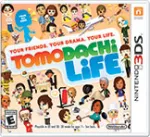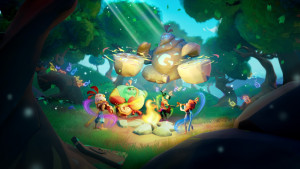Be the first to get Game Informer’s August Issue! Subscribe Now
Tomodachi Life Review

If Animal Crossing gives players a chance to join a community, Tomodachi Life is Nintendo's way of letting them create one from scratch. Unlike Nintendo's other life sim, you don’t have Tom Nook to tell you what to do or provide any sense of structure. You're free to inhabit the world with characters of your design and set your own goals.
Instead of being part of the town, you're equal parts god and surveillance camera, listening to the pleas of your islanders and peering into their windows (and occasionally, their minds). They ask for dating advice. If they’re hungry, you're the first to know. You help them sneeze. You don’t control their bizarre little lives; it’s more of an aquarium filled with people, and you are an observer with occasional input.
It all starts with character creation, where you design your Miis. In addition to futzing with noses, favorite colors, and all the usual stuff, you also get to tweak personality attributes on sliders, showing how fast or slow they are, if they lean toward being polite or direct, and a few other qualities. After that, you select their strange-yet-endearing robotic voices. When you're done, they move into an empty apartment and start living their lives.
Until you fill the apartment complex with more than a few Miis, you can’t do much. You can fill the vacancies by connecting with friends and populating your island with their creations. Characters wander around, ask for help with basic problems, and attend daily scheduled events like barbeques and magic shows. I made a point of creating more than a dozen inhabitants, and I made sure that several of them had opposing personalities. You can't make characters share apartments like in the Sims, but conflict finds a way.
After a few days of playing, a nexus of drama emerged – an elderly woman named Marge. She was aloof, boring, and not traditionally attractive. She also seemed to mesmerize nearly every male on the island. Within hours of joining my village, for example, one of my colleague Kim Wallace's Mii creations was head over heels in love with Marge. After getting some tips from me, he professed his love by singing a romantic song to her on the beach. A bit disturbingly, the Mii based on my five-year-old son (age and all) interrupted the proceedings, saying he wanted her heart, too. Alas, she chose neither. I consoled one of the heartbroken characters by giving him olives, then equipping a swing item and pushing him around for a while.

The events have a dreamlike quality – sometimes in the literal sense, like when you tap into a slumbering character's subconscious and see what's cooking. Other times, villagers do bizarre things that catch you off guard, such as spending a few minutes rolling around on the floor with smiles locked on their faces. And just like real dreams, you'll probably bore your real-world friends by sharing stories about what their not-quite-them counterparts were up to.
I enjoyed checking in several times a day and seeing what people were up to. It’s a great pop-in game, since you do spend the majority of your time watching as opposed to rotating chairs and shaking trees. That comes at a cost. After playing for about a week, I’ve started seeing events repeat themselves, which definitely reduces the overall novelty. A zany joke loses its power after you’ve heard it a few times. Similarly, I lost enthusiasm for my Miis’ eagerness to play games once I realized there were only a handful of these WarioWare-quality diversions.
If you thought Animal Crossing was too sparse on the gameplay front, Tomodachi Life’s superficial interactions may stretch your definition of the word “game.” In spite of the repetition, this island is a pleasant place to visit, even if I’m not ready to take up a permanent residence.














